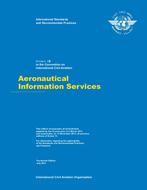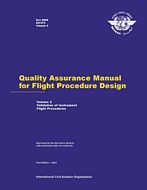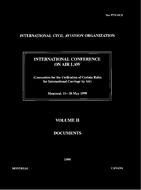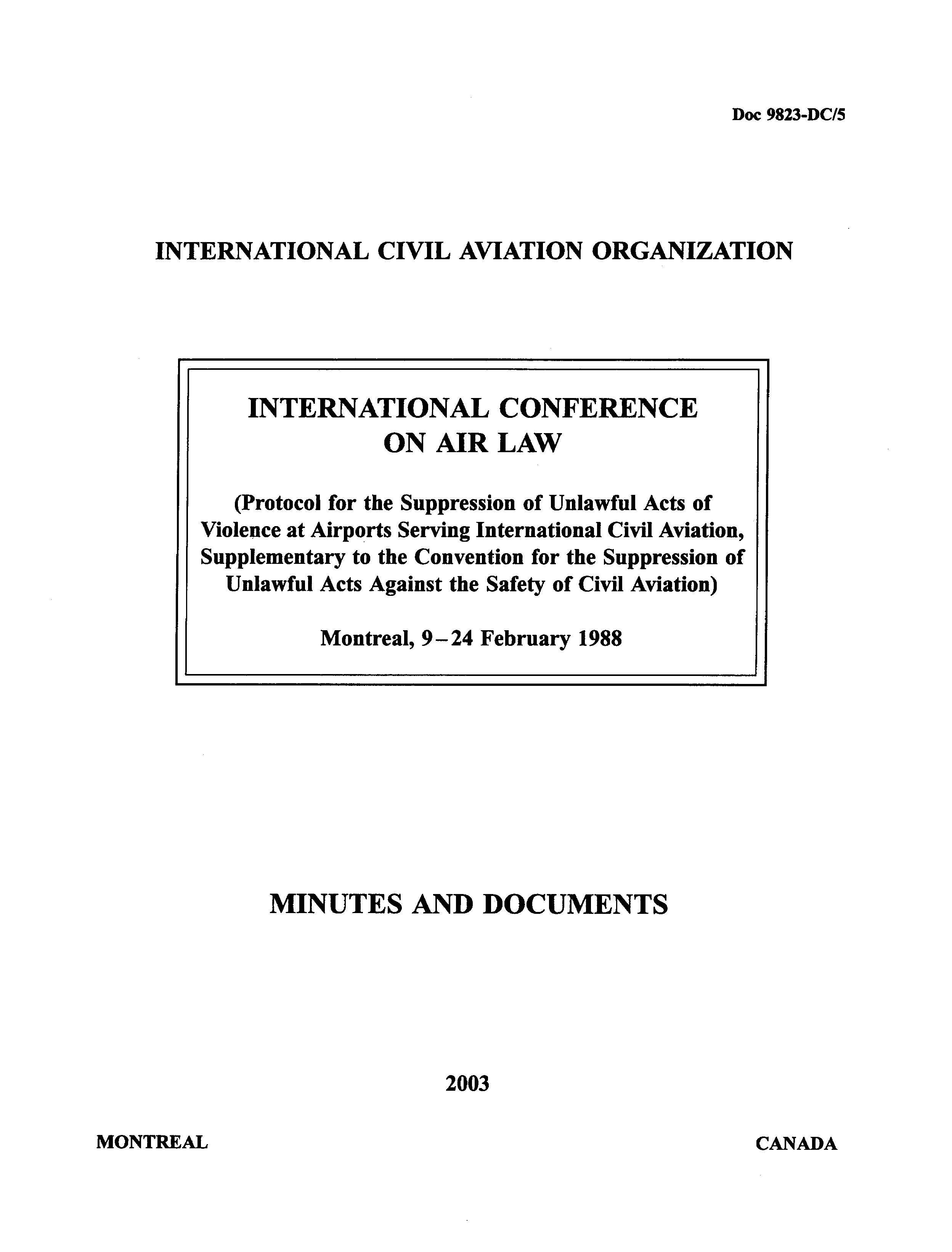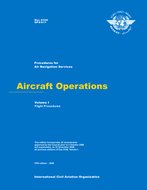Provide PDF Format
ICAO AN 15
- Annex 15 - Aeronautical Information Services, includes Amendments 1-38
- standard by International Civil Aviation Organization, 2013
- Publisher: ICAO
$62.00$123.00
Aeronautical Information Services
One of the least known and most vital roles in support of international civil aviation is filled by the aeronauticalinformation service (AIS). The object of the aeronautical information service is to ensure the flow of informationnecessary for the safety, regularity and efficiency of international air navigation.Annex 15 defines how an aeronautical information service shall receive and/or originate, collate or assemble, edit, format, publish/store and distribute specified aeronautical information/data. The goal is to satisfy the need for uniformity and consistency in the provision of aeronautical information/data that is required for the operational use by international civil aviation.
The ICAO Council first adopted the original Standards and Recommended Practices in 1953. Annex 15 has its origins in Article 37 of the Chicago Convention. The first requirements for the Annex were developed by the ICAO Air Navigation Committee (now the Air Navigation Commission), following recommendations from regional air navigation meetings, and were published by the authority of the Council as Procedures for International Notices to Airmen back in 1947.
"International notices to airmen" is a phrase which led to the birth of an early aeronautical acronym: NOTAM. In 1949, a special NOTAM meeting reviewed and proposed amendments to these procedures, which were later issued as Procedures for Air Navigation Services that became applicable in 1951. A total of 33 amendments updated Annex 15 over the years to meet the rapid changes brought about by air travel and associated information technology. In recent years, Annex 15 amendments have reflected the increased need for the timely provision of quality aeronautical information/data and terrain data as they have become critical components of data-dependant on-board navigation systems. The Annex now contains many provisions aimed at preventing corrupt or erroneous aeronautical information/data which can potentially affect the safety of air navigation.
The operator of any type of aircraft, be it small private aircraft or large transport aircraft, must have available a variety of information concerning the air navigation facilities and services that may be expected to be used. For example, the operator must know the regulations concerning entry into and transit of the airspace of each State in which operations will be carried out, as well as what aerodromes, heliports, navigation aids, meteorological services, communication services and air traffic services are available and the procedures and regulations associated with them. The operator must also be informed, often on very short notice, of any change affecting the operation of these facilities and services and must know of any airspace restrictions or hazards likely to affect flights. While this information can nearly always be provided before take-off, it must, in some instances, be provided during flight.
The philosophy underlying Annex 15, which stems from Article 28 of the Convention on International Civil Aviation, is that each State is responsible for making available to civil aviation interests any and all information which is pertinent to and required for the operation of aircraft engaged in international civil aviation within its territory, as well as in areas outside its territory in which the State has air traffic control or other responsibilities.
The information handled by an AIS may vary widely in terms of the duration of its applicability. For example,information related to airports and its facilities may remain valid for many years while changes in the availability of those facilities (for instance, due to construction or repair) will only be valid for a relatively short period of time. Information may be valid for as short a time as days or hours.
The urgency attached to information may also vary, as well as the extent of its applicability in terms of the number of operators or types of operations affected. Information may be lengthy or concise or include graphics. Therefore, aeronautical information is handled differently depending on its urgency, operational significance, scope, volume and the length of time it will remain valid and relevant to users. Annex 15 specifies that aeronautical information be published as an integrated aeronautical information package. It is composed of the following elements: the Aeronautical Information Publication (AIP), including amendment service, AIP supplements, NOTAM, pre-flight information bulletins (PIB), aeronautical information circulars (AIC), checklists and lists of valid NOTAM. Each element is used to distribute specific types of aeronautical information. Information concerning changes in facilities, services or procedures, in most cases, requires amendments to be made to airline operations manuals or other documents and databases produced by various aviation agencies. The organizations responsible for maintaining these publications usually work to a pre-arranged production programme. If aeronautical information were published indiscriminately with a variety of effective dates, it would be impossible to keep the manuals and other documents and databases up to date. Since many of the changes to facilities, services and procedures can be anticipated, Annex 15 provides for the use of a regulated system, termed AIRAC (aeronautical information regulation and control), which requires significant changes to become effective and information to be distributed in accordance with a predetermined schedule of effective dates, unless operational considerations make it impracticable.
Annex 15 also specifies that pre-flight information must be made available at each aerodrome/heliport normally used for international operations and sets the content of aeronautical information provided for pre-flight planning purposes as well as requirements for the provision of that information through automated aeronautical information systems. Additionally, there are requirements to ensure that important post-flight information provided by aircrews (for example, the presence of a bird hazard) are relayed to the AIS for distribution as the circumstances necessitate. The need, role and importance of aeronautical information/data have changed significantly with the evolution of the Communications, Navigation and Surveillance/Air Traffic Management (CNS/ATM) systems. The implementation of area navigation (RNAV), required navigation performance (RNP) and airborne computer-based navigation systems hasbrought about exacting requirements for the quality (accuracy, resolution and integrity) of aeronautical information/dataand terrain data .
The users' dependence on the quality of certain aeronautical information/data is evident from Annex 15, paragraph 3.2.8 a) which, when describing critical data, states: "There is a high probability when using corrupted critical data that the continued safe flight and landing of an aircraft would be severely at risk with the potential for catastrophe". Since corrupt or erroneous aeronautical information/data can potentially affect the safety of air navigation because of the direct dependence upon it by both airborne and ground-based systems, it is imperative that each State ensure that users (aviation industry, air traffic services, etc.) receive timely and quality aeronautical information/data for the period of its intended use.
To achieve this, and to demonstrate to users the required information/data quality, Annex 15 provides that States must establish a quality system and put in place quality management procedures at all stages (receiving and/or originating, collating or assembling, editing, formatting, publishing, storing and distributing) of the aeronautical information/data process. The quality system must be documented and demonstrable for each function stage, ensuring that the organizational structure, procedures, processes and resources are in place in order to detect and remedy any information/data anomalies during the phases of production, maintenance and operational use. Explicit in such a quality management regime is the ability to trace all information/data from any point, back through the proceeding processes, to its origin.
Of all the activities in international civil aviation, the provision and sustaining of aeronautical information services maynot rank among the most glamourous and indeed the complexity of AIS information supplying data-dependant on-board navigation systems may be transparent to the user, but without this service a pilot would be flying into the unknown.
Includes Corrigendum 1
One of the least known and most vital roles in support of international civil aviation is filled by the aeronauticalinformation service (AIS). The object of the aeronautical information service is to ensure the flow of informationnecessary for the safety, regularity and efficiency of international air navigation.Annex 15 defines how an aeronautical information service shall receive and/or originate, collate or assemble, edit, format, publish/store and distribute specified aeronautical information/data. The goal is to satisfy the need for uniformity and consistency in the provision of aeronautical information/data that is required for the operational use by international civil aviation.
The ICAO Council first adopted the original Standards and Recommended Practices in 1953. Annex 15 has its origins in Article 37 of the Chicago Convention. The first requirements for the Annex were developed by the ICAO Air Navigation Committee (now the Air Navigation Commission), following recommendations from regional air navigation meetings, and were published by the authority of the Council as Procedures for International Notices to Airmen back in 1947.
"International notices to airmen" is a phrase which led to the birth of an early aeronautical acronym: NOTAM. In 1949, a special NOTAM meeting reviewed and proposed amendments to these procedures, which were later issued as Procedures for Air Navigation Services that became applicable in 1951. A total of 33 amendments updated Annex 15 over the years to meet the rapid changes brought about by air travel and associated information technology. In recent years, Annex 15 amendments have reflected the increased need for the timely provision of quality aeronautical information/data and terrain data as they have become critical components of data-dependant on-board navigation systems. The Annex now contains many provisions aimed at preventing corrupt or erroneous aeronautical information/data which can potentially affect the safety of air navigation.
The operator of any type of aircraft, be it small private aircraft or large transport aircraft, must have available a variety of information concerning the air navigation facilities and services that may be expected to be used. For example, the operator must know the regulations concerning entry into and transit of the airspace of each State in which operations will be carried out, as well as what aerodromes, heliports, navigation aids, meteorological services, communication services and air traffic services are available and the procedures and regulations associated with them. The operator must also be informed, often on very short notice, of any change affecting the operation of these facilities and services and must know of any airspace restrictions or hazards likely to affect flights. While this information can nearly always be provided before take-off, it must, in some instances, be provided during flight.
The philosophy underlying Annex 15, which stems from Article 28 of the Convention on International Civil Aviation, is that each State is responsible for making available to civil aviation interests any and all information which is pertinent to and required for the operation of aircraft engaged in international civil aviation within its territory, as well as in areas outside its territory in which the State has air traffic control or other responsibilities.
The information handled by an AIS may vary widely in terms of the duration of its applicability. For example,information related to airports and its facilities may remain valid for many years while changes in the availability of those facilities (for instance, due to construction or repair) will only be valid for a relatively short period of time. Information may be valid for as short a time as days or hours.
The urgency attached to information may also vary, as well as the extent of its applicability in terms of the number of operators or types of operations affected. Information may be lengthy or concise or include graphics. Therefore, aeronautical information is handled differently depending on its urgency, operational significance, scope, volume and the length of time it will remain valid and relevant to users. Annex 15 specifies that aeronautical information be published as an integrated aeronautical information package. It is composed of the following elements: the Aeronautical Information Publication (AIP), including amendment service, AIP supplements, NOTAM, pre-flight information bulletins (PIB), aeronautical information circulars (AIC), checklists and lists of valid NOTAM. Each element is used to distribute specific types of aeronautical information. Information concerning changes in facilities, services or procedures, in most cases, requires amendments to be made to airline operations manuals or other documents and databases produced by various aviation agencies. The organizations responsible for maintaining these publications usually work to a pre-arranged production programme. If aeronautical information were published indiscriminately with a variety of effective dates, it would be impossible to keep the manuals and other documents and databases up to date. Since many of the changes to facilities, services and procedures can be anticipated, Annex 15 provides for the use of a regulated system, termed AIRAC (aeronautical information regulation and control), which requires significant changes to become effective and information to be distributed in accordance with a predetermined schedule of effective dates, unless operational considerations make it impracticable.
Annex 15 also specifies that pre-flight information must be made available at each aerodrome/heliport normally used for international operations and sets the content of aeronautical information provided for pre-flight planning purposes as well as requirements for the provision of that information through automated aeronautical information systems. Additionally, there are requirements to ensure that important post-flight information provided by aircrews (for example, the presence of a bird hazard) are relayed to the AIS for distribution as the circumstances necessitate. The need, role and importance of aeronautical information/data have changed significantly with the evolution of the Communications, Navigation and Surveillance/Air Traffic Management (CNS/ATM) systems. The implementation of area navigation (RNAV), required navigation performance (RNP) and airborne computer-based navigation systems hasbrought about exacting requirements for the quality (accuracy, resolution and integrity) of aeronautical information/dataand terrain data .
The users' dependence on the quality of certain aeronautical information/data is evident from Annex 15, paragraph 3.2.8 a) which, when describing critical data, states: "There is a high probability when using corrupted critical data that the continued safe flight and landing of an aircraft would be severely at risk with the potential for catastrophe". Since corrupt or erroneous aeronautical information/data can potentially affect the safety of air navigation because of the direct dependence upon it by both airborne and ground-based systems, it is imperative that each State ensure that users (aviation industry, air traffic services, etc.) receive timely and quality aeronautical information/data for the period of its intended use.
To achieve this, and to demonstrate to users the required information/data quality, Annex 15 provides that States must establish a quality system and put in place quality management procedures at all stages (receiving and/or originating, collating or assembling, editing, formatting, publishing, storing and distributing) of the aeronautical information/data process. The quality system must be documented and demonstrable for each function stage, ensuring that the organizational structure, procedures, processes and resources are in place in order to detect and remedy any information/data anomalies during the phases of production, maintenance and operational use. Explicit in such a quality management regime is the ability to trace all information/data from any point, back through the proceeding processes, to its origin.
Of all the activities in international civil aviation, the provision and sustaining of aeronautical information services maynot rank among the most glamourous and indeed the complexity of AIS information supplying data-dependant on-board navigation systems may be transparent to the user, but without this service a pilot would be flying into the unknown.
Includes Corrigendum 1
Related Products
ICAO 9906 V.5
Quality Assurance Manual for Flight Procedure Design - Volume 5 - Validation of Instrument Flight Pr..
$24.00 $47.00
ICAO 9775 Vol. 2
International Conference on Air Law - 1999 - Volume 2 -Documents (Doc 9775 Vol. 2-DC/2) - Conventio..
$280.00 $559.00
ICAO 9823
International Conference on Air Law (Protocol for the Suppression of Unlawful Acts of Violence at A..
$170.00 $340.00

